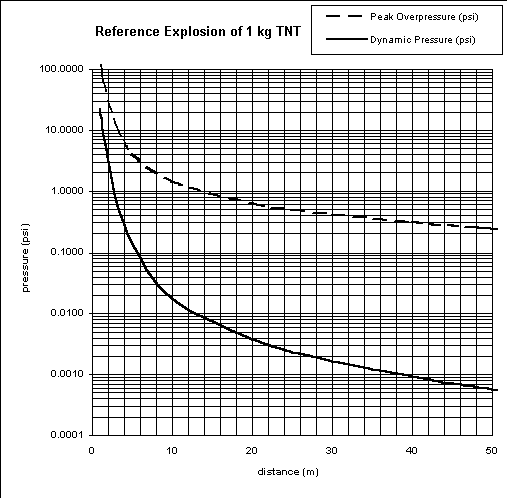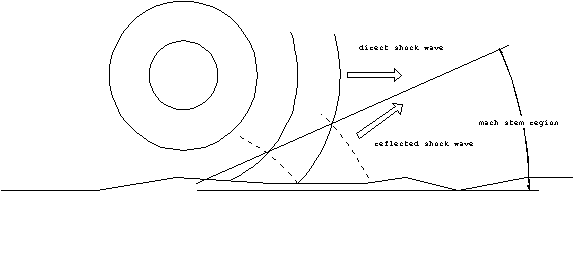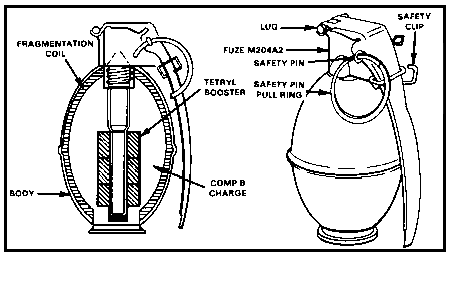
 Introduction to
Naval Weapons Engineering
Introduction to
Naval Weapons EngineeringWarheads

All of the sensors and guidance systems discussed so far have
one goal: to deliver a warhead to the immediate proximity of
the target. At this point, of course, the warhead will detonate
and hopefully disable the target. Warheads come in a wide variety
of designs, some only useful for special purposes. But the majority
cause damage in one of two simple ways: either by concussion
(blast effects) or by penetration with one or more fragments.
In order to understand the function of the warhead, we must first
learn what warheads can do and then how targets are vulnerable
to their effects.
Warhead Construction
The typical warhead has three functional parts: the fuze mechanism,
explosive fill, and warhead casing.

Figure 1. Parts of a warhead.
The fuze mechanism performs many functions. It contains the equipment
for detecting the proximity to the target and initiating the detonation
sequence, called the TDD device (for Target Detection and Detonation).
It also contains one or more safety mechanisms which prevent
inadvertent detonation of the main charge. Lastly, the fuze provides
the start of the high explosive train. It consists of the detonator,
which is a small amount of primary high explosive, and possibly
the booster charge.
When the explosive fill, which is a large amount of secondary
high explosive, is detonated, a large amount of heat will be released.
Initially, the explosion is contained within the casing. As
heat is added, the gaseous products will raise the pressure until
the casing can no longer contain it. At that point the casing
will burst and the gasses will rapidly expand. The casing will
break up into fragments which will be propelled outward at great
speed. The rapidly expanding gasses will compress the surrounding
air and create a shock wave which will propagate outwards at near
the speed of sound in air (~340 m/s).
There are two main effects which can cause damage to targets:
the high energy fragments of the casing and the shock (or blast)
wave. Warheads are usually designed to maximize one of these
effects. Fragments tend to be lethal to a greater range than
the blast effects, but it depends on the particular target. Aircraft
are particularly vulnerable to fragment damage as are personnel.
On the other hand, buildings can only be brought down by extensive
blast effects. We now turn to a detailed account of each type.
Blast Effects
The rapid expansion of the gaseous products after the
casing has burst creates a shock wave. The shock wave is an acoustic
wave like ordinary sound, but of limited duration and great energy.
Recall that the energy of the acoustic wave was a function of
the amplitude, or peak pressure. In shock waves, the peak pressure
is achieved only once, and is called the peak overpressure.
The peak overpressure is reached very quickly as the shock wave
passes, after which the pressure subsides more slowly.
Figure 2. Peak overpressure and dynamic pressure in a shock wave.
As the wave passes the pressure oscillates one or more times between
positive and negative phases. When the pressure is above the
ambient, the shock wave is considered to be in the positive phase.
The opposite condition is called the negative phase.
Due to the pressure differential within the shock wave,
the air will flow from high to low pressure. This creates a blast
wind, which can be of substantial velocity, well over 100 mph.
The blast wind only lasts for a fraction of a second and changes
direction during the negative phase. As the wind flows against
objects, they will feel dynamic pressure from the drag. The dynamic
pressure felt by an object follows the familiar equation for drag:
Pdyn = Cd ½rv2,
where:
Cd is the coefficient of drag for the particular object,
r is the density of air (normally ~1.2
kg/m3) , and
v is the velocity of the blast wind.
Predicting Blast Effects
Due to the complex nature of explosions, it is not possible
to easily predict the magnitude of these blast effects. However,
there is a vast collection of experimental data from the explosion
of 1 kg of TNT, which has been chosen as the reference explosion.
The values for an arbitrary explosion can be found be relating
it to the reference explosion through a relation known as the
scaling law. It relates the distances at which the same
effect will be felt for different explosive amounts. The scaling
factor is W1/3, where W = the equivalent amount of
TNT (in kg). W is found by multiplying the mass of the explosive
by its relative strength (RS). Explicitly:
dW = do W1/3
where:
do is the distance from 1 kg TNT
dw is the distance from the W kg of TNT equivalent.
Example: If a particular peak overpressure, (example: 1.5 psi)
is felt at 5 m from a 1 kg TNT explosion (the reference), estimate
how far away from a 10 kg PETN explosion, the same effect will
be felt.
The RS for PETN is 173% (from the Berthelot approximation).
W = 10 kg 1.73 = 17. 3 Kg
The scaled distance is therefore = (17.3)1/3 5 m =
12.9 m
The same scaling law will also hold true for dynamic pressures.
The peak overpressure and dynamic pressures are found
from the graph in Figure 3.

Example: Calculate the peak overpressure and dynamic pressure
felt by a person facing a blast of 10 kg of TNT equivalent, standing
5 meters away.
To use the graph, the distance must be scaled down to the reference
condition.
do = dw /W1/3
do = (5 m)/(10)1/3 = 2.3 m
Using the graph,
peak overpressure = 25 psi
dynamic pressure = 2.5 psi
Blast effect warheads are generally detonated above the
ground. This is done intentionally in order to take advantage
of constructive interference between the shock wave coming directly
from the warhead and the shock wave which is reflected from the
ground. At some distance away, the two waves will come together
and create a region with even greater blast effects. This is
known as the mach stem region.

In this region, both the peak overpressure and the dynamic pressure
will be almost double what would be felt if the warhead had detonated
on the ground. The height above ground which maximizes this effect
at a particular range is called the optimum height of burst.
This is used to determine the setting for the detonator.
Although this effect can greatly increase the effective range
of some weapons, it only has practical application to very large
bombs, and nuclear warheads. For smaller warheads, the extra
distance from the target resulting from the detonation above the
ground more than compensates for the increased pressures in the
mach stem region.
Fragmentation Warheads
Compared to warheads, which propagate their lethal effect
in the form of a shock wave, fragmentation warheads are generally
cheaper and have a greater lethal range. Principally, this is
because the energy of the fragments dissipates more slowly than
the energy of a shock wave. There are two major criteria for
fragmentation warhead design: will the individual fragments have
sufficient energy to damage the target and whether or not there
is a high probability that a fragment will actually hit the target.
The design of a fragmentation warhead is quite simple.
You only need to surround the explosive charge with a heavy casing,
which can also act as its container. When the charge detonates
it will build up sufficient pressure to burst the casing. If
the casing is pre-scored to separate into small pieces, the individual
fragments will be thrown outward at high velocity. Figure 5 is
a diagram of one of the simplest designs, the hand-grenade.

In this example, the body exterior of the explosive charge is
made up of a serrated fragmentation coil inside a thin sheet metal
casing. You may also notice the straight-forward use
of the high explosive train (comp-B is a secondary high explosive).
The kinetic energy of an individual fragment at some distance
from the explosion will depend on two factors: the initial velocity,
and the reduction in speed due to wind resistance.
The fragments will be thrown outward at a velocity which
depends on the nature of the explosive material (i.e. how energetic
the explosion is) and the configuration of the warhead. By configuration
we mean the mass of the explosive charge, the amount of material
available for fragments and the physical arrangement. A theoretical
analysis that predicted the initial velocities of the fragments
was done by R.W. Gurney in 1943. The velocity is a function of
three factors:
The heat of explosion per unit mass of the explosive material, DE, in J/kg. To convert from kJ/mol, you must multiply by 106 and divide by the molecular weight. For example DE = 616.4 kJ/mol of TNT. Since TNT has a molecular weight of 227 g/mol
DE = (616.4 kJ/mol)(1 mol/227 g)(103
J/kJ)(103 g/kg)
DE = 2.715 x 106 J/kg =
2.715 x 106 m2/s2
The configuration. For our purposes, we will only treat three
simple shapes: a flat plate, a cylinder and a sphere. Most warheads
will fall into one of these categories. For example, a land mine
is a flat plate, a 2000 lb. Bomb is a cylinder and a hand-grenade
is a sphere.
The ratio of explosive charge to fragmenting metal, C/M. This
is also known as the charge-to-metal ratio.
Here is the theoretical result:

where the value of K depends on the configuration:
Flat plate: K = 1/3
Cylinder: K = 1/2
Sphere: K = 3/5
The lead term, 
Example: find the initial velocity of fragments from a M-61 hand
grenade.
The M-61 uses 185 g of Comp-B (Gurney constant = 2843 m/s)
and 210 g of fragmenting metal casing.
The charge-to-metal ratio,
C/M = 185/212 = 0.87
Using the spherical factor for K = 3/5,
vo = (2843 m/s) (0.760)
vo = 2150 m/s
Reduction in Velocity with Range
As soon as the fragments are thrown outward from the casing,
their velocity will begin to drop due to wind resistance (drag).
The drag force is given by:
Drag = ½ rv2 Cd
A
where: r = The density of air. Normally
1.2 Kg/m3.
V = The fragment velocity.
Cd = The coefficient of drag. Depends on the shape
of the fragment and to some extent, the velocity.
A = The cross-sectional area of the fragment.
We can solve the equations of motion for the projectile and get
the fragment's velocity as a function of the distance traveled:
where s = the range, and v0 is the initial fragment
velocity.
Example- find the fragment velocity 100 m from the detonation
of a M61 hand grenade, given:
v0 = 2150 m/s
A = 1 cm2
Cd = 0.5
m = 2 g
We use the default value for the density of air. This gives a
velocity of
v(at 100 m) = (2150 m/s) e-(1.2 x 0.5 x 0.0001 x 100)/(2
x 0.002)
v = 480 m/s